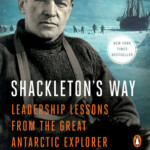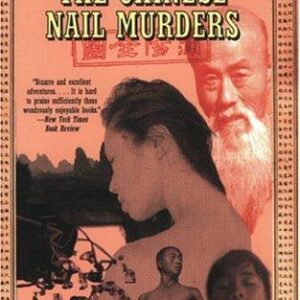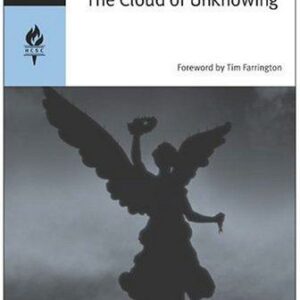Shackleton’s Way
$18.00
| Title | Range | Discount |
|---|---|---|
| Trade Discount | 5 + | 25% |
- Description
- Additional information
Description
Lead your business to survival and success by following the example of legendary explorer Ernest Shackleton
Sir Ernest Shackleton has been called “the greatest leader that ever came on God’s earth, bar none” for saving the lives of the twenty-seven men stranded with him in the Antarctic for almost two years. Because of his courageous actions, he remains to this day a model for great leadership and masterful crisis management. Now, through anecdotes, the diaries of the men in his crew, and Shackleton’s own writing, Shackleton’s leadership style and time-honored principles are translated for the modern business world. Written by two veteran business observers and illustrated with ship photographer Frank Hurley’s masterpieces and other rarely seen photos, this practical book helps today’s leaders follow Shackleton’s triumphant example.
“An important addition to any leader’s library.” –Seattle TimesShackleton’s WayPreface by the Honorable Alexandra Shackleton
Introduction
Shackleton resonates with executives in today’s business world. His people-centered approach to leadership can be a guide for anyone in a position of authority. Some of today’s leaders are successfully applying Shackleton’s methods to their own work situations.
1. The Path to Leadership
The values Shackleton learned from his family helped form his uniquely progressive leadership style. He worked his way into the forefront of a new field. He turned bad experiences into valuable work lessons. He insisted on respectful competition in a business climate that often demanded cooperation.
Former U.S. Secretary of the Navy Richard Danzig sees Shackleton’s broad cultural interests as a main ingredient of thoughtful leadership.
2. Hiring an Outstanding Crew
Shackleton built a crew around a core of experienced workers. He conducted unconventional interviews to find unique talent. His second in command was his most important hire. He looked for optimism and cheerfulness in the people he hired. He gave his staff the best compensation and equipment he could afford.
James Cramer credits Shackleton’s optimistic example with saving his hedge fund and TheStreet.com from an early demise.
3. Creating a Spirit of Camaraderie
Shackleton made careful observations before acting. He established order and routine so all workers knew where they stood. He broke down traditional hierarchies. He was fair in his dealings with his staff. He used informal gatherings to build espirit de corps.
Eric Miller, a senior adviser at Donaldson, Lufkin & Jenrette, sees Shackleton’s strategy as fitting well into today’s workplace.
4. Getting the Best from Each Individual
Shackleton led by example. He understood and accepted his crewmen’s quirks and weaknesses. He used informal one-on-one talks to build a bond with his men. He was always willing to help others get their work done. He helped each man reach his potential.
Luke O’Neill runs Shackleton Schools in New England to put into practice Shackleton’s message about individual achievement.
5. Leading Effectively in a Crisis
Shackleton let everyone know that he was in charge and confident of success. He inspired optimism in everyone. He put down dissent by keeping the malcontents close to him. He got everyone to let go of the past and focus on the future. He worked to keep spirits high. He sometimes led by doing nothing.
Jeremy Larken of Octo Ltd. uses Shackleton as a model for intelligent leadership facing a crisis.
6. Forming Teams for Tough Assignments
Shackleton balanced talent and expertise in each team. He ensured all his groups were keeping pace. He remained visible and vigilant. He shored up the weakest links. He got teams to help each other.
Apollo 13 commander James Lovell sees similarities in how Shackleton and he led their crews through crises.
7. Overcoming Obstacles to Reach a Goal
Shackleton took responsibility for getting the whole job done. Even “Old Cautious” sometimes took big risks. He found the inspiration to continue. He kept sight of the big picture. He stepped outside his work to help others.
Jaguar’s retired chief of North American operations, Mike Dale, used Shackleton’s story to spur his sales crew to new heights.
8. Leaving a Legacy
Shackleton’s leadership had a lifelong impact on his crew. His appeal spans generations. His lasting contributions to leadership. He influenced a pioneer project in space. Using his example to promote social change. How we view Shackleton’s success today.
Shackleton’s Crews
Bibliography
Acknowledgments
Index
“An important addition to any leader’s library.” –Seattle Times
“A first-rate business partner.” –Publishers Weekly
“Even though its target market is leaders and managers, Shackleton’s Way has much broader appeal and application.” –The Boston GlobeMargot Morrell, a twenty-year veteran of corporate America, has worked in financial services and consulting. Her research into Shackleton’s leadership has taken her to such far-flung destinations as Antarctica, Australia, and Argentina.
Stephanie Capparrell, a journalist for more than twenty years, is an editor for the Wall Street Journal‘s Marketplace page.The Path to Leadership
When Ernest Shackleton was at the zenith of his popularity as an explorer, he was invited back to his boys’ school, Dulwich College in London, to present some academic honors. That was about as close as he ever got to a Dulwich prize, he joked, to the cheers of the students.
Indeed, Shackleton’s early years revealed little promise of the glories to come. An early biographer, Hugh Robert Mill, a friend and mentor of the explorer, joked that the only sign in Shackleton’s childhood that he would go to the Antarctic was a class ranking that was decidedly “south of the equator and sometimes perilously near the Pole.” At the time of the Dulwich speech, a teacher interviewed by a schoolboy magazine remembered the young Shackleton as “a rolling stone.” Students and teachers alike saw the boy as an introvert who was more interested in books than in games but who had a hard time with his studies. “He could do better,” was a common refrain in school reports.
One classmate did see a hint of Shackleton in the making. He recalled some forty years after the incident how the young student had beaten up a schoolyard bully who had been picking on a smaller boy. From an early age, Shackleton gravitated to the role of protector, stepping up to the front to insist on fair play.
Ernest Henry Shackleton was a natural as a big brother. He was born on February 15, 1874, in Kilkea, County Kildare, Ireland, the second of ten children. He was a healthy and good-looking boy, with slate blue eyes and dark hair. His family and closest friends saw him as humorous, imaginative, and mischievous. By all accounts, he grew up in a loving home surrounded by attentive females. In addition to his eight sisters, his grandmother and aunts often helped his mother with the children. It is no wonder that many people would later remark on his strong feminine sensibilities. Despite a burly physique; enormous stamina; and a tough, no-nonsense manner, he could be nurturing and gentle, quick to forgive frailties, and generous without seeking thanks in return. One friend called him “a Viking with a mother’s heart.” Both men and women saw this duality in Shackleton and found it irresistible. Shackleton himself was aware of it: “I am a curious mixture with something feminine in me as well as being a man…. I have committed all sorts of crimes in thought if not always in action and don’t worry much about it, yet I hate to see a child suffer, or to be false in any way.”
The family home had its own split personality, according to Dr. Alexander Macklin, the physician on two of Shackleton’s three independent expeditions. He wrote that Shackleton’s Irish mother, Henrietta Gavan, was “warm-hearted and altogether happy-go-lucky.” His father Henry, on the other hand, was “a grave, cautious, solid Yorkshire Quaker.” A Shackleton ancestor had immigrated to Ireland in the eighteenth century to open a school. Shackleton’s father ran a farm and settled his family in the lush land of county Kildare. When Ernest was six years old, the elder Shackleton left farming to study medicine at Trinity College in Dublin. He became a homeopathic doctor, a vocation that provided the family with solid, upper middle-class comforts.
Shackleton learned from his family a broad and sympathetic view of the world that helped shape his evenhanded, democratic leadership style.
Henry Shackleton headed a strict, though apparently not oppressive, household. The Bible was read aloud in the home, and young Ernest, who had flair for the dramatic, led his siblings into the children’s temperance movement. They would gather outside pubs, singing songs about the perils of alcohol-a display of youthful activism that suggests the family’s religious bearings. Sir Ernest’s branch of the Shackletons left the Quaker religion in the late eighteenth century to join the Church of England. It seems, however, that the family maintained some of its Quaker culture. In the late nineteenth century, Quakers were active worldwide in many progressive political movements: abolition, prison reform, education reform, pacifism, women’s suffrage, and the temperance movement, which held that alcohol was a chief cause of family violence and poverty.
Throughout his life, Shackleton was described as being ahead of his time in his attitude toward and treatment of his men. He also encouraged his sisters to always express themselves and develop their own careers, and they became impressively self-sufficient women for their day, choosing vocations such as artist, midwife, customs officer, and writer. As an adult, Shackleton would abandon temperance and other religious practices and embrace his share of vices. But he maintained his faith and his moral compass, balancing his contemplative, spiritual side with a practical, humanistic commitment. Later in life, Shackleton’s wife wrote a bio-graphical note for Dulwich alumni in which she stated her husband was “interested in social welfare movements.” Ultimately, his authority as a leader rested on his genuine regard and respect for the men he led.
If Ernest Shackleton had anything in common with his father it was that they both pursued their interests with great passion. The edler Shackleton relished domesticity, never more content than when poring over scientific texts at his last family home in Sydenham, in London. He lived there for thirty-two years, tending to his medical practice, his family, and a meticulously kept rose garden. Ernest, by contrast, loved poetry and the sea. He was to become famously incapable of staying put, going to the ends of the earth to seek adventure. What he definitely didn’t want was to follow his father’s wish that he become a doctor.
Ernest was ten years old when his family moved to England. His spoken English forever retained traces of his Irish roots and so he was always identified, for better or for worse, as an outsider. His Anglo-Irish culture helped shape his independent mindset, giving him a healthy disregard for custom, clan, and class.
In England, Shackleton was sent to school for the first time. He was eleven years old. Until then, his father had educated him and his siblings at home. From the start, Shackleton showed a certain discomfort in a formal classroom setting, and wasn’t destined to stay long in it. His first school was Fir Lodge in Croydon, south of London. Shackleton’s classmates teased the newcomer, goading him and another Irish boy to fight each other on St. Patrick’s Day. The boys gave him the nickname “Micky,” and he adopted it for life, signing his name as such in letters to his wife and close friends.
When he was thirteen years old, Shackleton was sent to Dulwich College, a solid boys’ school attended mostly by day students who were the children of professionals. He was seen as immature and inattentive to schoolwork, so was often placed with students a year younger. One teacher reported that the young Shackleton “wants waking up.” Another predicted, “He has not yet fully exerted himself.” a schoolmaster who met Shackleton after he had become a famous explorer confessed, “We never discovered you when you were at Dulwich.”
“No,” Shackleton replied sympathetically, “but I had not then discovered myself.”
Shackleton complained the school didn’t make things interesting. Geography was “names of towns, lists of capes and bays and islands,” he said. Worse, it took great poets and writers and made them dull by “the dissection, the parsing” of their work. Shackleton seemed a typically moody teen, but he was never disruptive or rebellious. Instead, he plotted an escape. He announced at fifteen years of age that he was going to leave home for life on the seas. “I wanted to be free,” he wrote later. “I wanted to escape from a routine which didn’t at all agree with my nature and which, therefore, was doing no good to my character. Some boys take to school like ducks to water; for some boys, whether they take to it or not, the discipline is good; but for a few rough spirits the system is chafing, not good, and the sooner they are pitched into the world, the better. I was one of those.”
The decision greatly pained Henry Shackleton but he didn’t stand in his son’s way. Rather, he used family connections to help him secure a decent cabin-boy position. Shackleton’s mother, an unconventional woman who had her own subscription to the schoolboy publication Boys Own Paper, encouraged him to pursue his dreams so he would have no regrets later.
Shackleton joined the merchant marine, learning the rugged, freewheeling, commercial culture of the service. Shackleton gave notice to the school but finished the 1890 spring term while waiting for his position to be settled. Once he had fixed on a goal and purpose, he at least was motivated to apply himself. He began to excel as a student, shooting up to fifth place in a class of thirty-one boys. It was the awakening his teacher had said he needed. After finishing the term, he traveled to Liverpool and joined the crew of the sailing ship Hoghton Tower.
Once his choice was made, Shackleton saw his commitments through to the end.
Shackleton was homesick and unhappy for most of the first four years of his apprenticeship at sea. He had left the protective bosom of his religious, largely female household and had thrown himself into the hard-boiled sailor’s world. Initially, he was under no contractual obligation to stay, but he refused to quit. He was determined to complete the difficult apprenticeship and launch a career. “I don’t think I ever formulated any definite idea as to what all this rough work was leading up to,” he said, “but I dreamed prodigiously about big things ahead, big things in the nature of adventure.”
The work was rougher than anything Shackleton had daydreamed about at his desk at school. He swabbed decks, polished brass, and did backbreaking work loading and unloading cargo. Biographer H. R. Mill described one assignment to pick up a shipment of rice from India and bring it to Mauritius: “a horrible job, for every one of the 2,600 bags, each weighing 170 pounds, that were to be loaded each day, had to be passed along the deck from hand to hand.” The rough sacks tore at Shackleton’s hands and so bruised them that the boy apologized in letters home that his writing was so brief and in such poor penmanship. “That such a system of loading cargo could exist even on sailing ships in the last decade of the Victorian age, so renowned for its mechanical achievements, is not a little surprising,” Mill said.
It was dangerous work. The crew sometimes encountered weeks of violent storms that shredded the ship’s sails, carried off lifeboats, and tossed the men about. During the worst storms, the young boys would be lashed to the ship to prevent them from being washed overboard. Shackleton saw one crewman get swept away in one of a relentless series of storms. Nine were bedridden by accidents then, and Shackleton was nearly crushed by falling tackle. He developed lumbago after spending weeks in wet clothes and a wet bed. Later, he suffered dysentery. Once, when the boys were tied up during rough seas, one of the ship’s brutes purposely smashed Shackleton’s foot with his heavy boot. Shackleton fell to the ground and sank his teeth into the man’s leg-and didn’t let go. After that, he was left alone.
Shackleton found much about the crew intolerable. Even allowing for the usual embellishments of a boy’s letters home, he complained bitterly to his parents about how much he abhorred the drinking, swearing, and gambling that surrounded him. (He did admit to have picked up smoking.) The ports offered no respite. They were seedy, violent places to the young boy, and Shackleton chose to spend his evenings aboard ship under the stars, finding solace in the beauty of nature. He wrote in one letter: “Many a painter would have given half of what he possessed to have been able to catch the fading tints of the red and golden sunset we had last night…. All I say is, if you wish to see Nature robed in her mantle of might, look at a storm at sea; if you want to see her robed in her mantle of glory, look at a sunset at sea.”
On his first assignment, Shackleton worked under a compassionate captain who invited the apprentices to his dinner table and held Sunday sessions of hymn singing in his cabin. The atmosphere was such that Shackleton, to his amazement, could read his Bible without harassment from his shipmates. Some even joined him.
His next captain, however, was far less kind and ran a ship that was less disciplined and demanded harder work. Shackleton’s Bible study made him the object of ridicule by the others. Consequently, he began practicing his religion more privately and let his actions speak for his beliefs.
By his third and last apprentice voyage, he was horribly homesick. To allay his misery on the two-year trip, Shackleton wrote hundreds of letters home and demanded hundreds in return-postcards didn’t count.
After completing four years of apprenticeship on clipper ships carrying freight, Shackleton began taking exams every two years to advance to higher posts. By the age of twenty, he had secured a job as third officer on an elite passenger liner. By the age of twenty-four, he had earned his master’s certificate, qualifying him to serve as captain of any ship in the merchant marine. He had a new reason to chase success: He was in love with Emily Dorman, a cultured Londoner several years his senior. He wanted a respectable career and the financial security to marry her.
As he matured, Shackleton became more confident and more demanding. He wanted better working conditions, more promising work, and colleagues he could respect. He got what he wanted, thanks to a winning combination of hard work, savvy political instincts, and charm. Early in 1899, he joined the prestigious Union Castle Line. Shackleton figured his new employer would put him in the company of more ambitious peers and well-connected passengers. He worked relentlessly to make contacts and ask for introduction to others. He wasted no time finding a mentor either. While serving as fourth officer aboard the Tantallon Castle, Shackleton met-and dazzled-a rich steel maker by the name of Gerald Lysaght. Lysaght was struck by the twenty-five-year-old officer’s “unusual character-power and determination” and was convinced that he was destined for great things. For the rest of his life, Shackleton benefited from this patron’s financial support of his expeditions.
The force of his personality also had a magnetic effect on his superiors and colleagues. The following year, Shackleton was offered the position of fourth mate on the Tintagel Castle, a large steamer carrying troops to fight in the Boer War between Great Britain and Dutch colonists in South Africa, but convinced the captain to give him third officer’s post instead. Shackleton distinguished himself in service on the ship, going far beyond the basic duties required. He had developed an idea of how business should be conducted on a ship and how he would conduct himself. He also started to get a sense of his professional goals.
Shackleton decided to write a book about his experiences, coauthored with the ship’s surgeon, Dr. W. McLean. Its unwieldly title tells something of their task: O.H.M.S.: A Record of the Voyage of the Tintagel Castle: Conveying 1,200 Volunteers from Southampton to Cape Town, March 1900. When he boldly asked the immensely successful writer Rudyard Kipling to write an introductory poem for the book, Kipling obliged. “I will do my level best for you,” Shackleton quotes the author as telling him when they met. Shackleton, never one to leave anything to chance, sold the book to readers before it had been written. He took two thousand advance orders, assuring himself a tidy profit. When the book was published in late 1900, the confident Shackleton had a copy specially bound for the queen.
Even after Shackleton became an explorer famous for his incredible stamina in searching for the South Pole, he would speak with pride of how he made it through his difficult initiation to life on the sea and seemed always to carry some sympathy for the poor apprentice he had been. Years of unhappy apprenticeship had hardened him and at the same time made him more compassionate toward those who became ill, miserable, or homesick. He learned other lessons he never forgot: that a good boss could make the burden of work seem lighter, that refusing to use the best tools available unfairly burdens workers, and that one person could change an entire work environment. Shackleton also learned some things about himself: that he had a love for nature that sometimes was stronger than his love of civilization, that he liked being center stage, and that he craved a big success.
In every job he held, Shackleton helped boost the morale of the crew.
By the time Shackleton joined the Tintagel Castle, his more boisterous side had emerged. He had become acutely mindful of the importance of shipboard morale. He couldn’t work effectively in a hostile or vulgar atmosphere and doubted that others could either. He didn’t try to convert the unruly crewmen though, as he had attempted in his youth. By the age of twenty-six, he had found a better way to get crews to act civilly.
On the Tintagel Castle, Shackleton volunteered to teach the military officers signaling. The ship was an unpleasant place to work; it was extremely crowded with troops and staff, and the ship’s officers kept a tight rein on discipline. The crew was demoralized. Shackleton took it upon himself to plan diversions for his mates: sports, concerts, and an elaborate staging of the coming of Father Neptune-a tradition when crossing the equator. Shackleton’s efforts lifted the men’s spirits and he became, in the words of one crewman, “the life and soul” of the ship. It was the first time anyone had said that about Shackleton, but it would not be the last. He would be known on every ship he served for his penchant for giving nicknames, for organizing activities, for his shenanigans, and for quasi-serious experiments.
Over the years, Shackleton developed his ability to connect with people into a real talent for giving entertaining speeches in any variety of forums-an office, a fundraising dinner, a press interview. But he probably was given credit for being more of a natural hail-fellow-well-met than he really was. Every indication was that he worked hard at creating a public persona. He saw how vital it was to his success to be someone people liked and wanted to be around, and wanted to give money to. But Shackleton kept a side to him that craved to be alone with his books and to enjoy the calm and quiet of wide-open spaces.
Shackleton read broadly to find wisdom and guidance for all life’s journeys.
Shackleton was determined that his abbreviated formal education not handicap him in the world of wealth and power to which he aspired. He taught himself navigation and seamanship, and whatever else he needed to pass the exams for promotion. More important, he read a broad array of literature. Shackleton crisscrossed the globe in his service to the merchant marine, visiting Europe, South America, the Far East, the Middle East, China, Africa, and the United States. But nothing opened his mind to the vastness, richness, and complexity of the world the way his books did. They took him beyond the scope of his personal experience. A friend described Shackleton’s cabin on the Tintagel Castle: “On one side a writing table, with the wall behind covered with photos of friends, and on the other wall a bookcase with the signs of a well-read owner, for in it I saw Shakespeare, Longfellow, Darwin, and Dickens, as well as books on navigation.”
Shackleton was a lifelong student of history and poetry. In an interview, he suggested how he came to be such an enthusiastic reader after his lackluster performance in school: “I was never much taken with records of battles and sieges, and dynasties, and dethronements, but of the history of a people struggling to be free, of adventurous nations who sent their mariners into unknown seas, and the history of colonization and exploration.”
His education intensified when he met Emily Dorman. She introduced him to museums, art, and lectures and sparked in him a deep appreciation for the poetry of Robert Browning, who would be a particular guiding light for Shackleton for the rest of his life. Shackleton’s father already had imbued in him a fondness for Alfred Lord Tennyson, England’s poet laureate who was so popular at the end of the Victorian age. Browning and Tennyson represented for Shackleton the two main compass points of his world: Tennyson’s view was tender and passive; Browning’s was bold and hungry for living. “I tell you what I find in Browning is a consistent, a spontaneous optimism,” biographer Harold Begbie quoted Shackleton as saying. “No poet ever met the riddle of the universe with a more radiant answer. He knows what the universe expects of man-courage, endurance, faith-faith in the goodness of existence.”
Shackleton’s reading on many topics made it easy for him to connect to many people and their interests. Years later, when stranded on the ice, he would prod the men into debates about things like the different types of love, the differences between the Orthodox and Catholic churches, the treatment of blacks in America. “I envied him no end in the way he was always apt in any quotation he made, filling an occasion or anything that happened,” one of his men, Lionel Greenstreet, said about him.
Shackleton kept an eye on new horizons, ready to seize opportunities.
Shackleton read with the rest of the world the fascinating news that the Belgica had left Punta Arenas, Chile, in December 1897, with plans to become the first scientific expedition to the Antarctic and to take the first photographs of the region. This event set his life on an entirely new course. He saw the potential and anticipated the popularity of Antarctic exploration and set out to acquire a new set of skills. In 1899, he joined the Royal Geographical Society (RGS), where he was exposed to the culture of exploration.
When the RGS and the Royal Society, an independent scientific academy, decided in 1900 that Britain should fund a national Antarctic expedition of their own, Shackleton was ready. He immediately began a hard campaign to go. A new century was dawning, and ambitious men like him saw endless possibilities and changes afoot. Electricity was revolutionizing home life and industry. Steamers had all but replaced sailing ships. With polar exploration, every corner of the world would be known for the first time. And speculation that Antarctica’s ice covered valuable resources made the expeditions seem a shortcut to wealth.
The advances made by explorers and scientists stirred the same kind of heady excitement felt at the dawn of the twenty-first century with the expansion of technology and the move into cyberspace: A new, unknown world was up for grabs, and with it a sense that money and fame were easily attainable-and that everyone had a shot at them. The world seemed to be moving faster and faster.
One of Shackleton’s crewmen, Thomas Orde-Lees, imagined in 1915, with some accuracy, what the world would look like a century later: “No doubt the explorers of 2015, if there is anything left to explore, will not only carry their pocket wireless telephones fitted with wireless telescopes but will also receive their nourishment and warmth by wireless means and also their power to drive their motor sledges, but, of course, there will be an aerial daily excursion to both Poles then.”
Shackleton was ready to leave his old career behind. His last commercial voyage was aboard his largest ship yet, the Carisbrooke Castle, a passenger ship bound for the Cape of Good Hope. When he returned from the two-month trip in early 1901, he received word that he had been appointed junior officer on the Discovery, the Antarctic expedition ship to be led by Robert F. Scott. The news delighted Shackleton. He immediately was thrust into the limelight, where he demonstrated his talents for dealing with the public and courting the press. The Discovery set sail for Antarctica on July 31, 1901 with thirty-eight men, arriving at McMurdo Sound early the following year. The crew’s excitement made for a lively voyage. Shackleton had an advantage over most of the other young officers in that he was an experienced sailor. Exploration ships had to use a combination of sails and steam because the long journeys south posed refueling problems. Most of his shipmates had trained on steamers and had to learn sailing techniques.
Shackleton had to learn how to perform scientific experiments. H. R. Mill, the multitalented scientist at the Royal Geographical Society, sailed as far as Madeira to tutor the crew in science. He taught Shackleton how to measure saline levels and water density and perform other tests. He found Shackleton impatient with the precision demanded by scientific work, but otherwise a good student who took criticism well.
Shackleton again was called “the life and soul” of the ship by the Discovery crew. He stirred up the crewmen, amusing them with inventions like a sledge with wheels made from rum barrels. All the while he did exceptional work. He was the first member of the expedition to find vegetation; he was the first to spot new land, which was called Edward VII Land; he did a fine job editing the South Polar Times, the ship’s publication. He also improved the packing of the sledges, having studied the inefficiencies of their first sledging efforts. Suffice it to say that two of his colleagues on that ship, Louis Bernacchi and H. R. Mill, were so taken with the twenty-seven-year-old novice explorer that both wrote about his extraordinary leadership abilities after his death. Mill, who became a close, lifelong friend of Shackleton’s, wrote a rich biography.
Scott chose Shackleton and the expedition physician Edward A. Wilson to accompany him on the “Great Southern Journey,” an attempt to make the 1600-mile trek to the Pole and back that began in November 1902. The long march in the Antarctic cold over treacherous terrain demanded extra heat-giving and strength-building nourishment. Scott, however, skimped on the rations to lighten the loads on the sledges. By Christmas, all three men showed signs of scurvy. They were forced to turn back 460 miles short of the Pole on the last day of the year. Shackleton, in particular, was in a fight for his life. In addition to starvation and scurvy, he was suffering from what appeared to be heart and lung ailments. The bedraggled trio just made it back to the ship on February 3, 1903. Far from feeling sympathetic or even responsible for his stricken colleague, Scott seemed to blame the march’s failure on Shackleton’s weak constitution. The Discovery expedition may have advanced Antarctic exploration as a whole, but there was little concrete to show for the two-year effort. Worst of all, one seaman died early on in an accident.
Overall, Scott was unwilling or unable to adapt his formal naval training to the harsh and unfamiliar environment. Frozen in the waters off the Antarctic, for example, he conducted formal inspection on deck every Sunday. He also made the crew swab the deck, even though water froze as soon as it hit the boards.
Despite the fact that Shackleton had made a good many of the contributions logged by the Discovery crew, in March 1903-halfway through the expedition-Scott demanded that Shackleton volunteer to return home on the relief ship. Shackleton resisted, having by that time been well on the road to recovery. Scott, however, threatened to send him back in disgrace if he didn’t declare himself sick.
Shackleton turned a setback into an opportunity to make a big move on his own.
Shackleton was bitterly disappointed about being sent home. The bad feelings between Scott and Shackleton that developed over the course of the expedition were never mended. But Shackleton never publicly retaliated. Instead, he did his rival one better: He used his early return to steal some thunder from the Discovery’s later arrival home. He beguiled the public with dramatic tales of derring-do on the mysterious continent. Shackleton found people had an insatiable curiosity about the South, and he took full advantage of it. The publicity helped burnish his reputation as an expert expedition planner. He was called upon to help the Argentine government plan an Antarctic relief expedition to leave supplies on Paulet Island. At about the same time, he helped organize the transport of ten-thousand Russian soldiers to the front during the Russo-Japanese war.
Shackleton also tried a series of other jobs, though all with the intent of using what he learned and earned to further his career in exploration. He first tried his hand at journalism, editing copy at Royal Magazine, where his boss was clearly smitten with his charm. The editor said Shackleton’s enthusiasm and creative thinking would have been valuable in any workplace. “I am convinced that if he had gone to a stock-broker, a butcher, a carpenter, or a theatrical manager and asked for a job, he would have got it. There was something about him that compelled confidence,” F. W. Everett explained. “And none of these good folk would have regretted taking him on. Though stock-broking and acting may have been as little in his line as journalism, he would have made his mark in them somehow or other…. He was brimming over with original, unconventional, racy ideas, which, whether practical or not, were always stimulating and suggestive.”
Shackleton used his three months at the magazine to make valuable connections and to learn how to handle the media. He had donated fees from one article to the Discovery Relief Fund. Scott’s ship had become trapped in the Antarctic ice, and had to be dynamited out in February 1904 at great expense.
Using his contacts at the RGS, Shackleton then moved to Edinburgh and became an influential officer of the Royal Scottish Geographical Society. He made his mark there too. As the new secretary of the society, he was credited with boosting membership by five hundred.
By this time, his finances had improved sufficiently to marry Emily Dorman on April 9, 1904. The couple would go on to have three children: Raymond, Cecily, and Edward. Emily never got used to the long separations and disruptions of their family life. Shackleton’s letters to her over the years are full of repeated promises to give up exploration, and repeated apologies for not doing so. Still, the couple remained together, and Emily never remarried after her husband’s death.
Shackleton even dabbled-unsuccessfully-in politics. He felt he was popular enough to try a run for Parliament as a Liberal-Unionist for Dundee in the 1906 elections. He was a crowd pleaser but didn’t pull in votes. He was soundly defeated. After the election, he became a personal assistant to Sir William Beardmore, a Glasgow engineering magnate who introduced Shackleton to a circle of prominent businessmen.
Shackleton followed his dreams.
–Reprinted from Shackleton’s Way by Margot Morrell and Stephanie Capparell by permission of Penguin Books, a member of Penguin Putnam Inc. Copyright (c) 2002 Margot Morrell and Stephanie Capparell. All rights reserved. This excerpt, or any parts thereof, may not be reproduced in any form without permission.
US
Additional information
| Weight | 7.8 oz |
|---|---|
| Dimensions | 0.6000 × 5.2600 × 7.9500 in |
| Imprint | |
| ISBN-13 | |
| Author | |
| Audience | |
| BISAC | |
| Subjects | business books, Travel books, travel book, money, mindset, agile, autobiographies, entrepreneurship, MBA, self help books for women, motivational books, travel gifts, Ernest Shackleton, management books, inspirational books for women, high output management, leadership books, management books for new leaders, shakleton, motivation, adventure, business management, management, business, self help, biography, BUS046000, leadership, creativity, history, travel, BIO023000, confidence, self help books, economy, bucket list, habits, biographies |
| Format |












